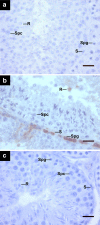Effects of chronic heat stress on the expressions of heat shock proteins 60, 70, 90, A2, and HSC70 in the rabbit testis
- PMID: 21830018
- PMCID: PMC3227842
- DOI: 10.1007/s12192-011-0287-1
Effects of chronic heat stress on the expressions of heat shock proteins 60, 70, 90, A2, and HSC70 in the rabbit testis
Abstract
Few studies have focused on the expression of heat shock proteins (HSPs) after chronic heat stress. The objective of this study was to investigate the effect of chronic high temperature-humidity index treatment on the expressions of HSP60, HSP70, HSP90, HSPA2 and HSC70, in the Rex rabbit testis and the expressions of these proteins after recovery from the chronic heat shock. Thirty mature male rabbits of the same age were randomly divided into three groups: control, heat stress, and recovery. The western blot results showed that the expressional levels of HSP60, HSP90, and HSC70 increased significantly and HSPA2 was elevated slightly after a 9-week heat treatment. HSP70 was absent in the control testis and had a high level of expression after heat stress. All of these proteins partially reverted back to normal levels after a 9-week recovery. The immunohistochemical results indicated that the expression patterns of HSP60, HSP90, HSPA2, and HSC70 did not change.
Figures




References
Publication types
MeSH terms
Substances
LinkOut - more resources
Full Text Sources
Research Materials
Miscellaneous

